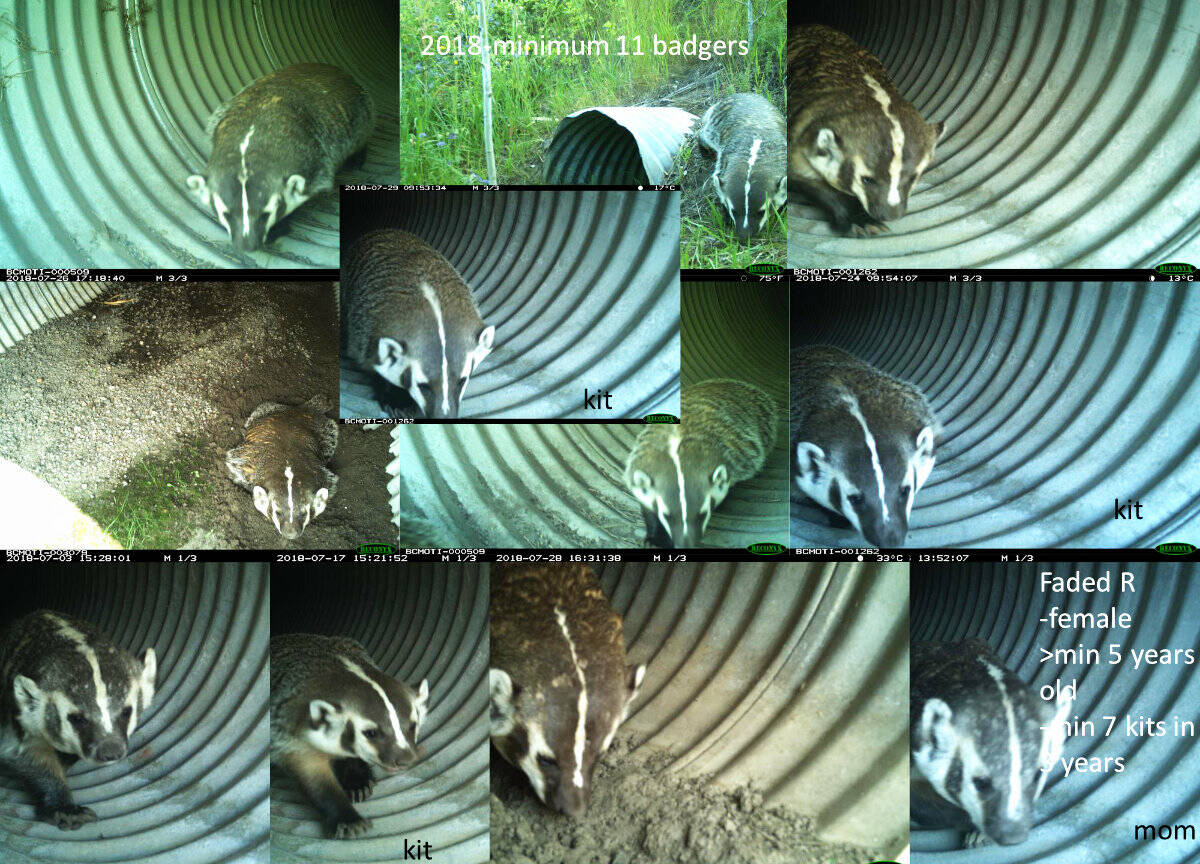We may not see them walking the streets but dozens of American Badgers make the South Cariboo their home.
The evidence is in their stripes. Researchers have found that the white stripe running down the middle of a badger’s face is as unique an identifier as a human’s fingerprint. It’s thanks to those stripes Roger Packham, a habitat biologist, has been able to track the movements of badgers across the Cariboo over the last 20 years.
“From photos that we’ve got of badgers going through culverts, there’s their stripe in the middle of their face and in between their eyes. It’s like a fingerprint and they’re all different. So through facial identification, looking at the stripe, yes, we can identify the number of individuals that we had,” Packham said.
The badger is red-listed in BC, meaning it is an endangered species, and before 2003 there were less than 10 documented sightings of badgers or their burrow locations within the entire Cariboo in the B.C. Conservation Data Centre’s information network.
READ MORE: BC conservation officers release badger from wolf trap
In the same year, Packham came across a burrow that was too small for a coyote and too big for a marmot or ground squirrel. Not knowing what had created the burrow, he set up a camera and got a photo of a badger.
“So, at that time again, we had less than 10 known sightings or information in the entire Cariboo so in 2003 I discovered, if you will, badgers in the Cariboo.”
After obtaining funding he went looking for more burrows from the air. They were able to spot several burrows on south-facing slopes during the spring melt. Packham said even though they are good swimmers badgers do not like moisture and prefer the drier south-facing slopes.
Things escalated from there and he started getting involved with the Badger Recovery Team and began talking with other badger experts in the province.
Through research conducted in the Kootenays and the Thompson region, scientists discovered the main mortality factor for badgers is roadkill. Around 2007-2008 Packham partnered with Thompson Rivers University and graduate student Richard Klafki came up to do his Master’s thesis on badger ecology.
Klafki documented significant numbers of badgers being killed on highways in the Cariboo and Packham estimates that over the last 20 years, they have documented about 220 dead badgers along Highway 97, which is about the provincial badger population.
The three main mortality hotspots are between Knife Creek and 150 Mile House, 100 Mile House and Canim Lake Road and the 108 Mile Ranch and Lac La Hache.
“We think we’ve got about 250 badgers, maybe up to 300 badgers, in the entire province right now. We’ve lost that population in the Cariboo over the last 20 years,” said Packham. “But what Richard Klafki found, and again, I can get you the specific numbers. But for every one that dies on the highway, there are another 1.6 animals that crawl off the highway and then die. So we only know that they’re never picked up. They’re never recorded. And we only know that because Richard had radio transmitters in his badgers.”
Packham said if you were to multiply the confirmed number of badgers killed on the highway (220) by 1.6 it is a significant number as the population would be that much higher if these animals were still alive.
Knowing that being hit by vehicles is the main mortality factor for badgers, Packham has been working with highways and funding agencies to monitor badger movements through culverts running under the highway. Since 2018 he has had 14 cameras mounted in culverts between 100 Mile and Williams Lake, documenting badgers and other animals using the culverts rather than crossing over the highway.
While there are around 10 culverts in the Cariboo designed specifically for use as wildlife crossings, the majority of culverts are for drainage.
“And so, from this monitoring, what I found is that badgers and long-tail weasels, least weasels, ground squirrels, there’s a number of species that won’t use these culverts when they’re wet.”
Of the 52 culverts between 100 Mile and Williams Lake several are blocked from dirt and sand falling into them. If they are dry culverts that badgers and other animals would use to cross under the highway, Packham will clean them out to release any water trapped inside. Those that are too big a job for a shovel he makes note of and “then later on, hopefully, money is made available for these culverts to be dug out by a machine.”
When asked if there is anything people can do to reduce highway mortality for badgers Packham said,
“A lot of people aren’t going to even see them, they’re certainly not going to slow down for them. You should never swerve for an animal regardless of the size. You can slam on the brakes but in my opinion, you don’t ever want to swerve. It will miss the animal but it could cost you your life.”
You always need to be aware of your surroundings, especially here in the Cariboo, he said. One time he was driving to Williams Lake on a bright and sunny morning when he noticed an animal coming down the hill towards the highway. When it jumped the fence and ran onto the highway the motorist in front of him hit it.
“Yet I watched it for three or four or five minutes come all the way down the hill and jump over the fence but that vehicle in front of me obviously didn’t watch any of that and hit that animal.
100 Mile HouseCaribooWilliams Lake


